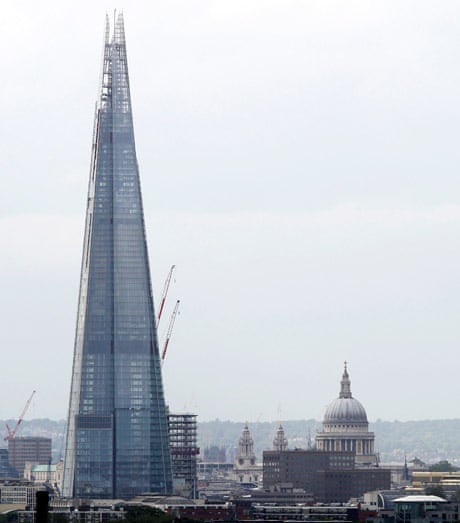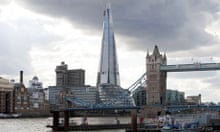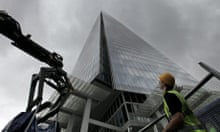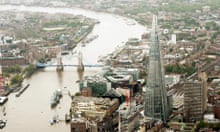Next Thursday, a giant metaphor will be launched in London. The prime minister of Qatar will fly over especially; his supporting act will be Prince Andrew. Foreign dignitaries will be treated to a lavish dinner; lowly residents of the capital can gawk at a free laser show that threatens to out-do George Lucas.
This is how developers plan to "inaugurate" the Shard, the 72-storey skyscraper that already stalks Londoners everywhere they go. It glowers over your conversations in Peckham; it skulks in your eyeline as you amble along Hampstead Heath. Get up close to Europe's tallest tower, and its 1,017 feet (getting on for twice the height of the Gherkin) render everything around it toylike, laughable.
The money men behind the Shard would like the rest of us to treat it merely as a building. Ideally, you'd marvel at its jutting architecture (the work of Renzo Piano, don't you know); failing that, they'd take you castigating its arrogant flashiness.
But before falling for the predictable Shard-en freude, we should think again. Because what is approaching completion over on London's South Bank is almost the perfect metaphor for how the capital is being transformed – for the worse. The skyscraper both encapsulates and extends the ways in which London is becoming more unequal and dangerously dependent on hot money.
Consider again the story of the Shard. This is a high-rise that has been imposed on London Bridge despite protests from residents, conservation groups and a warning from Unesco that it may compromise the world-heritage status of the nearby Tower of London. What's more, its owners and occupiers will have very little to do with the area, which for all its centrality is also home to some of the worst deprivation and unemployment in the entire city. The building is 95% owned by the government of Qatar and its developer, Irvine Sellar, talks of it as a "virtual town", comprising a five-star hotel and Michelin-starred restaurants.
It will also have 10 flats that are on sale for between £30m to £50m, and from where on a clear day it will be easier to gaze out on to the North Sea, 44 miles away, than at the beetle-sized locals 65 floors down below. "We won't really market these apartments," the PR man cheerily told me. "At this level of the market, there are probably only 25 to 50 possible buyers in the world. The agents will simply phone them up."
So one of London's most identifiable buildings will have almost nothing to do with the city itself. Even the office space rented out at the bottom is intended for hedge funds and financiers wanting more elbow room than they can afford in the City or Mayfair. The only working-class Londoners will presumably bus in at night from the outskirts to clean the bins. Otherwise, to all intents and purposes, this will be the Tower of the 1%.
Perhaps the most remarkable thing about the Shard is that it simply exemplifies a number of trends. First, it merely confirms how far the core of London is becoming, in industrial terms, a one-horse town. Finance, which began in the Square Mile, has now spread to Docklands to the east, to Mayfair in the west and now to the South Bank.
Second, it proves that buildings are no longer merely premises owned by businesses, but are now chips for investment. What's more those chips are increasingly owned by people who barely ever set foot in the country. A study from Cambridge University last year, Who Owns the City?, found that 52% of the City's offices are now in the hands of foreign investors – up from just 8% in 1980. What's more, foreigners are piling into London property at an ever-increasing rate, as they look for relatively safe havens from the global financial turmoil. And yet, as the Cambridge team point out, the giddy combination of overseas cash and heavy borrowing leaves London in a very precarious position. Another credit crunch, or a meltdown elsewhere in the world, would now almost certainly have big knock-on effects in the capital.
The same story applies to London's housing market, too. Earlier this year, the upmarket estate agent's Savills noted that Britons now made just over one in every three property purchases in the posh parts of central London. "The more central the market and the more expensive the property, the more likely it is to be purchased by an overseas buyer or foreign national," their report noted.
London has historically always been the point at which foreign money enters Britain, and disperses in search of a place to invest. But, as Louis Moreno of University College London points out, what's happened over the past 15 years is that an unprecedented amount of foreign money has come into London – and lodged there, in its property. The cash hasn't gone into productive enterprises that will benefit or employ ordinary Londoners. It has sat in plush new flats or office blocks. And now it's setting up its biggest home yet, on the South Bank.
So, the Shard: it's expensive. It's off-limits. It's largely owned by people who don't live here. And it is the perfect metaphor for what our capital is becoming.





